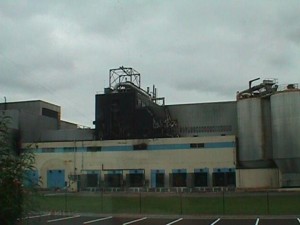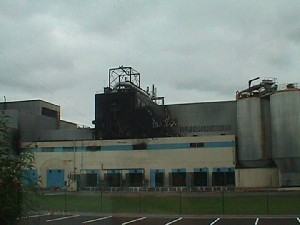A fire broke out around 2:50 am in an electrical utility room at a paper mill. Engulfed in the flames, four transformers emptied entirely and a fifth halfway, dispersing a dielectric containing PCB. A prefectural order motivated by a proposal from the inspection authorities for classified facilities was issued given the risk of contamination by dioxins and furans generated during the fire. The order commissioned investigations to determine the extent of contamination and shut down the facility. The re-commissioning was subject to the operator producing supporting documents and authorisations provided for in the prefectural order.
A total of 96 individuals present at the time of the accident (including fire-fighters, employees, journalists and neighbours) had to undergo epidemiological supervision for a full year. The trajectory of smoke led to delimiting a 2.5-km cone-shaped zone for future monitoring and a ban on consuming plant products. About one hundred samples of soot, building materials, soils, water and plants revealed the presence of dioxins and furans at higher concentrations near the site of emission.
A prefectural order dated 4 July 2001 set forth conditions for the partial and gradual re-commissioning of the facilities (stripping of soil and cleaning) and imposed identification and closure of all onsite PCB facilities within a year.
Taking into account the 3 series of analysis on plants, soil, water that revealed PCB and dioxin levels within the daily admissible limits, the ban on exterior land was lifted 25 days later. The quantity of PCB lost equalled approximately 600 kg (of the 2,800 kg initially included), and the quantity of dioxins emitted was 13 kg. The building that caught fire was completely destroyed, with damages estimated at 15.2 million euros. The fire may have resulted from a short-circuit or the poor condition of an electrical component. The “transformer fire” scenario had not been investigated in the safety study.
In all, 26 transformers containing PCB were gradually removed from the site until August 2002. Despite the initiatives taken by the inspection authorities for several years, the removal of transformers damaged by the fire and the stripped soil was still being finalised in summer 2008
The management of the accident also highlighted the need of close consultation between the various departments of the national authorities, a real-time communication for the various players involved, as well as follows up of the actions taken by the operator.
Download the detailed report in .pdf format (91 Kb)





